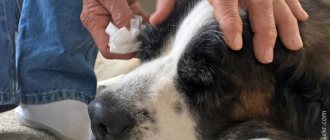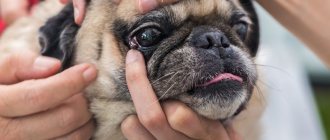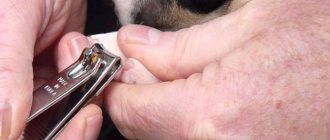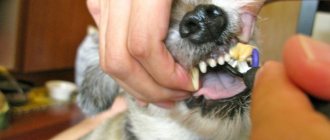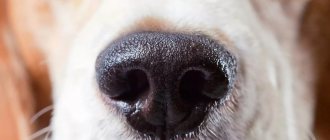Not all owners know how to wipe their dog’s eyes and how often they need to be cleaned. The algorithm and frequency of washing depend on the purpose pursued and the health of the animal. In some cases, ordinary water is not enough - special preparations from a human first aid kit or a pet store can cope with serious contaminants and pathologies.
Why do you need to rinse your dog's eyes?
In dogs, discharge periodically accumulates in the inner corners of the eyes. Normally, they should be colorless or have a grayish tint. The presence of watery fluid indicates the normal functioning of the lacrimal apparatus, which is necessary to moisturize the cornea and mucous membrane.
Due to the anatomy of their paws, dogs cannot clean their eyes on their own. Therefore, the owner must provide regular care. Washing allows you to avoid suppuration and the development of dangerous infectious diseases. Owners of the following breeds should approach the procedure carefully:
- with large, drooping eyelids;
- with bulging eyeballs;
- with a brachycephalic head shape;
- with thick and long hair in the eyelid area, on the head.
In addition, with age, pets develop a pronounced dullness of the cornea. This occurs due to a decrease in the production of tear secretion. This feature increases the risk of chronic conjunctivitis, blindness and accumulation of purulent discharge.
Common Dog Eye Problems
The eyes are the dog's most vulnerable organ. Pets often have problems related to:
- with injuries to the organs of vision;
- foreign bodies getting into them;
- swelling and inflammation, copious discharge;
- anatomical defects;
- deterioration of visual function.
If a dog begins to vigorously rub its eyes with its paws, swelling appears around them, and the eyeballs themselves turn red, this is most often due to small foreign objects getting into them. A pet is not able to remove a foreign body on its own.
In such a situation, the animal owner will be required to:
- try to detect a small object in the dog's eye. To do this, you need to squeeze the dog’s muzzle between your knees and gently open your eyelids;
- If a visible foreign object gets into the organs of vision, you should carefully rinse the animal’s eyes with boiled or distilled water, using an eye dropper. If you pull back the eyelid, the foreign body may come out on its own. It is not recommended to use tampons or cotton swabs - this can seriously damage the cornea.
If you are unable to cope with the problem on your own, you should immediately call a veterinarian at home or go to the clinic.
You should remember the rules that will help your pet maintain his vision.
- Any pathological discharge, purulent, mucous or bloody, is grounds for a visit to the veterinarian.
- Any injury to the eye area, including a blow, scratch or bite, is grounds for an urgent visit to the veterinarian.
- Any visible changes in the sclera, cornea or mucous membrane (turbidity, redness, appearance of strange spots, loss of transparency) are grounds for a visit to the veterinarian.
When should you be wary?
Caring for your dog's eyes should be regular; examinations should preferably be carried out weekly, as well as after each long walk through forests or areas with a lot of bushes. You should be wary if purulent discharge of a yellow-green hue appears. They may appear due to the following reasons:
- viral or bacterial infection;
- disruption of eyelash growth and eyelid structure;
- chronic blepharitis, conjunctivitis or keratitis.
In rare cases, excessive tearing is observed with allergies of any nature, ingress of dirt and dust, or injuries to the cornea. The main signs of vision problems in a dog are:
- narrowing of the palpebral fissure;
- very frequent blinking;
- the animal rubs its head with its paws;
- redness of the mucous membrane, burst vessels;
- swelling of the eyelids.
In practice, conjunctivitis is the most common cause of suppuration. This is an inflammation of the outer layer of the eye. Appears against the background of infection, mechanical damage or regular exposure to dirt.
When should a veterinarian perform the procedure?
Any damage to the organ of vision, if measures are not taken in time, can lead to serious complications. You should consult a doctor if the following symptoms appear:
- The dog rubs its face and eyelids with its paws, and may whine.
- There is pain in the area of the organ of vision.
- Visible mucous membranes are red, dilated vessels are visible.
- Swelling is noted in the area of the upper and lower eyelids.
- A large number of expirations.
- The pet squints the affected eye.
- The general condition is depressed, appetite is reduced or absent.
Pathologies that symptoms may indicate:
- allergic reactions;
- entry of a foreign body;
- irritation from chemicals;
- viral infection;
- pathologies of the urinary system;
- hormonal abnormalities;
- improper eyelash growth;
- injuries;
- pathologies of the eyeball and its structures.
Eye washes
In practice, a variety of solutions are used to wash a dog's eyes. Among them there are ready-made medications, as well as traditional methods. In order not to make a mistake in choosing a solution, it is recommended to consult a veterinarian. An examination by a specialist is required if there is heavy purulent discharge over a long period of time.
Pharmacy solutions
Suitable for the treatment of diseases and regular preventive rinsing. They are sold in regular pharmacies, but before the procedure you need to reduce the dosage, since the anatomy of canines is different from that of humans. Effective solutions:
Sodium chloride
Isotonic solution containing regular salt. Its composition is similar to physiological fluids (plasma, tears). Sold in a dosage of 0.9%, does not require dilution with water. Recommended for regular dog eye care. The advantage is safety for the pet’s body, low price.
Furacilin
Antiseptic solution for the treatment of bacterial eye infections. It is used if it festers, for example, with frequent mechanical damage to the cornea. To create a working solution, mix 20 mg (1 tablet) per 100 ml of clean water. It is advisable to only wipe your eyes with Furacilin.
Chlorhexidine
Antiseptic, sold in human pharmacies in bottles of various sizes. Solution concentration – 0.05%. To treat a dog, it must be diluted with water or saline in a ratio of 1:5 (4 ml per 20 ml of water). Used for instillation, wiping and rinsing.
Ready-to-use washes
Your veterinary clinic or pharmacy sells special eye care products for dogs. They do not require ready-made dilution; the active substance is contained in the optimal dosage for the animal. Usually prescribed for the treatment of eye diseases, after surgery to prevent complications. For example, with blepharoplasty. Effective drugs:
- Diamond eyes. Veterinary antiseptic drops for the treatment and prevention of ophthalmic diseases. The active component is chlorhexidine in reduced concentration.
- Tsiprovet. Antibiotic drops for dogs. The drug is used to treat bacterial conjunctivitis and corneal injuries with severe suppuration.
- Albucid. Drops containing sodium sulfacyl. It has a powerful antimicrobial effect and is recommended for the treatment and prevention of conjunctivitis.
- Tobrex. Antibacterial drops for the treatment of infectious eye diseases and inflammation. The duration of treatment and frequency of use are prescribed by the veterinarian depending on the clinical characteristics.
- Solcoseryl. Therapeutic gel with a regenerating, healing effect. Suitable for treating trauma.
The choice of a specific solution, its dosage and treatment regimen should be made by the attending veterinarian. It is not advisable to treat your dog with Miramistin or any other strong antiseptic yourself without knowing the proportions for preparing the solution.
Folk remedies
Homemade solutions are often used to wash the dog's eyes prophylactically. They are weakly effective, but are completely safe for the pet’s sensitive body. Basic methods:
- Camomile tea. The product has a wound-healing, anti-edematous effect. Relieves inflammation, suitable for removing impurities. To prepare 1 tbsp. l. dry chamomile, pour 200 ml of warm water, let it brew for 20 minutes. Cool before use.
- Tea. For eye care, you can use a weak tea leaves. It removes secretions well, has a mild tonic and anti-inflammatory effect. Rinsing your eyes with tea can be done at any age.
Apply all home remedies directly on the day of preparation. It is strictly forbidden to use them if they turn sour or acquire an unpleasant odor.
General rules for hygiene procedures
- The animal's eyes need to be examined daily.
- All manipulations must be carried out with clean hands. Wash your hands with soap and dry them thoroughly.
- Do not use cotton wool to wash your eyes. Small cotton fibers can cause irritation to the eyelids and eyeballs.
- You should not restrain the animal before carrying out the procedures; it may become very frightened. Any violence will cause the dog to stop trusting you. During washing, you need to talk calmly with the animal. Dogs are good at distinguishing the emotional coloring of speech.
- After washing, the dog should be praised, stroked and given a treat.
- Washing movements should be carried out in the direction from the ears to the nose. You only need to clean your eyelids; you should not touch your eyeballs.
- You cannot remove foreign objects from the animal’s eyes yourself. You can injure your dog's eyes. Surgery should only be performed by doctors.
- Eye wash solutions should be warmed to room temperature.
- Rinsing is most conveniently done using a small syringe. The fluid pressure should be weak.
- You need to use a separate napkin to wipe each eye.
- After washing the dog's eyes, wipe with a dry swab.
- Various solutions are instilled into the corner of the eye, which is located closer to the nose. After this, the drops are naturally distributed over the surface of the eyeball (this occurs due to intense blinking movements). Do not touch your eye with the dropper or the edge of the tube. You may cause discomfort to the animal.
How to wash your dog's eyes at home
Clean the dog’s eyes at least once a week, and also increase the intensity of the procedures when there is an active accumulation of secretions. Treatment is carried out using medications; home remedies can also be used for prevention. Before starting work, prepare cotton pads, rinsing agent and treats to reward the dog after manipulation. All movements should be smooth and slow so that the pet does not feel stress or aggression.
Step-by-step algorithm of actions
You need to be careful when using pharmaceutical products. They can cause discomfort and tingling. How to wash your dog's eyes:
- Fix your head and hold your torso tightly. Representatives of small breeds can be wrapped in a blanket or towel.
- Soak a cotton pad in the medicinal solution. Rub your eyes with it, moving from the outer corner to the inner part. Do not put pressure on the eyeball; if it dries out, replace the disc.
- If dried crusts have accumulated, they must first be moistened - with a cotton pad or napkin heavily moistened in the solution, moisten the required area. And then rinse your eyes yourself.
Some products are produced in the form of drops, which makes eye treatment easier. Using two fingers, slightly spread the eyelids and drop the required amount of the drug into the upper corner. Simulate blinking by closing and opening your eyelids with your hands.
If you are using the drug in the form of an ointment, then pull the lower eyelid with your hand and squeeze a small amount onto the mucous membrane. Close your eyelids to blink. Immediately after the procedure, offer the dog a treat to distract the pet from discomfort.
Do not try to play the role of a doctor and treat an animal.
Medicines are sold in pharmacies in the form of lotions, drops and ready-made solutions. You can also purchase sanitary napkins for your eyelids. The drugs have different prices and purposes. The listed remedies should be used with caution.
If rinsing does not help, the dog must be taken to the veterinarian. Before purchasing a medicine, you need to carefully study its composition. You should not take solutions that contain antibiotics, hydrogen peroxide, ethyl alcohol and other aggressive chemical components.
What to do in case of emergency
If you notice that the dog is acting restless and scratching its head, and the cornea is inflamed and there is a large amount of pus, then urgent measures need to be taken. Carefully examine the eyes and, if necessary, carefully remove the foreign body. Moisten a cotton pad with saline solution and gently wipe each eye. Contact your veterinarian as soon as possible to determine the cause of the disease and prescribe treatment. Throughout the entire period of therapy, monitor your pet’s behavior and undergo regular scheduled examinations. Report any complications or the appearance of atypical features.
Prevention
To avoid dangerous ophthalmological diseases, suppuration and early clouding of the cornea, simple preventive measures should be followed. Useful tips:
- systematically cleanse the eyes of pus, rinse with chamomile, sterile water or saline;
- when bathing, avoid getting shampoo on the mucous membrane, which can cause irritation of the mucous membrane;
- monitor the length of the hair in the head area, thin out the eyebrows in a timely manner;
- treat chronic diseases, adjust the daily diet taking into account taste preferences, age and physical activity.
Some breeds are recommended to undergo surgery to change the length and area of the eyelids during childhood (Shar Pei, Basset Hound). Blepharoplasty improves your pet's appearance and helps avoid serious problems in the future.
Other whitening cosmetics
whitening gel (USA) provides safe and effective removal of stains from urine, tears, saliva, food, and also strengthens hair. The transparent gel is applied to dry fur with a brush or hands. It is removed after some time or remains on the coat for 2-3 days. Fresh stains are removed without a trace after 1-2 applications of the gel. Old stains require more time to remove - use the gel daily for 7-10 days. The cost of the gel is about 1300 rubles.
Whitening spray conditioner Ring5 Whitener Cleaner (USA) enhances whiteness (optical illusion), preserves the natural silky texture of the hair and adds volume. The cosmetic mask masks the yellowish tint and removes dust.
Conditioner Anti-Yellowing eliminates yellowness, restores and strengthens hair. Does not cause irritation and does not cause dryness. The conditioner is applied after washing the coat with shampoo (Iv San Bernard Cristal Clean Shampoo Anti-Yellowing whitening shampoo is available on sale) for a few minutes, then rinsed off with water. The cost of an air conditioner is approximately 1200 rubles.
In cases where the coat is lightly colored, a whitening effect can be achieved by using gentle cosmetics that contain natural moisturizers of natural origin (hyaluronic acid, chitosan), coconut oil, and vitamins.
Briefly about the main thing
- Eye discharge in dogs is a natural physiological process. Normally, they should be moderate and transparent.
- Pay attention to suppuration in the cornea area. This may be a symptom of injury, chronic diseases (keratitis, blepharitis, conjunctivitis).
- Pharmaceutical preparations, veterinary solutions and home recipes are used to care for the eyes. Treatment should be selected only by a doctor.
- For prevention and regular care, you can rinse or instill chamomile infusion, sterile water or diluted saline solution.
How often and with what do you wash your dog’s eyes? Share your experience in the comments to the article.
Features of the treatment of various eye diseases
It is not always possible to eliminate eye disease in a dog by washing or instilling drops. Serious illnesses require a general approach and special treatment measures. Often, in addition to medications, surgery is used.
Eyelid swelling and blepharitis
The treatment is complex. Prescribe proper feeding and improve living conditions. The causes of the disease are determined and eliminated: the diet is changed, medications are replaced, etc. Antihistamines are prescribed orally or parenterally:
- diphenhydramine;
- tavegil;
- diazolin;
- trexil;
- diprazine
Local treatment: removal of scales and crusts after lubricating the ciliary edge of the eyelids with fish oil or castor oil, and then applying one of the antibacterial ointments: tetracycline, sulfacyl, dibiomycin, gentamicin, calendula, kanamycin, furacillin, oxytracycline, ditetracycline, erythromycin, florenal. Topical medications that reduce itching are used:
- ointments - hydrocortisone ophthalmic, celestoderm, elocom, acortin;
- eye drops - dexona, dexamstazone-oftan, drops with diphenhydramine.
In case of long-term course and relapses, corticosteroid drugs are prescribed briefly orally in small doses: dexamethasone 1 tablet 2-3 times a day, prednisolone 1 tablet 2-3 times a day. For swelling of the eyelids, in addition, diuretics are used: diacarb, furosemide.
When treating ulcerative blepharitis, the first few days the ulceration site is carefully lubricated with an alcohol solution of brilliant green, or a solution of silver nitrate, or a solution of sulfacyl.
Cotton swabs should be used carefully
For a long-term course, autohemotherapy and vitamin therapy are used. Biogenic stimulants are injected subcutaneously: liquid aloe extract, FiBS, vitreous body, peloid distillate and at the same time broad-spectrum antibiotics: chloramphenicol, gentamicin, smallpox, ciprofloxacin.
Viral conjunctivitis
Treatment of the underlying disease. Antiviral agents are used locally: acyclovir, poludan, deoxyribonuclease, anandin, as well as ointments: tebrofen, florenal, zovirax. Local ointment and oral bonafton tablets. To suppress secondary microflora, a solution of chloramphenicol and dibiomycin ointment are used.
A solution of amidopyrine with adrenaline, citral, vitamin drops, etc. have a good effect. At night, fish oil is instilled or a synthomycin emulsion or thiamine ointment is injected into the conjunctival sac.
Follicular conjunctivitis
A solution of zinc sulfate is used locally, as well as complex formulations of zinc sulfate with boric acid, adrenaline, and furacillin. Eye drops with alum and boric acid, with protargol are instilled into the conjunctival sac, and eye films are also placed. Subsequently, a hydrocortisone suspension, dexon drops, diphenhydramine solution, amidopyrine solution, sofradex, amphotericin, dekta-, drops with benzyl penicillin, amandine are used.
In case of exacerbation of the process and significant discharge from the eyes, a solution of sulfacyl sodium, sulfapyridazine sodium, chloramphenicol, furacillin, conjunctivitis is prescribed. If necessary, a solution of prednisolone with gentamicin is injected under the conjunctiva once a week.
In chronic cases, biogenic stimulants are used: aloe extract, vitreous body, pelloid distillate, as well as antibiotics and sulfonamide drugs.
Corneal wounds
It occurs due to microtrauma of the corneal epithelium and exposure to staphylococci, streptococci, and Pseudomonas aeruginosa. Broad-spectrum antibiotics and sulfa drugs are immediately prescribed. Solutions and ointments of kanamycin, chloramphenicol, benzylpenicillin, sulfacyl, sulfapyridazine sodium are used locally.
Treatment regimen:
- Tobrex, ch. drops 1 drop 5 times a day
- Balarpan (Interpan), ch. drops 1 drop 5 times a day
- Korneregel, ch. gel 1 drop 5 times a day.
- The interval between drugs is 10 minutes, the drugs are sold in a human pharmacy.
Foreign bodies found on the surface of the cornea in case of superficial damage must be removed after anesthesia. To prevent the development of infection, it is necessary to rinse the eye with an antibiotic or furatsilin solution. Subsequently, ointments are used to heal the corneal layer (tetracycline, solcoseryl).
As decongestant and anti-inflammatory therapy for the cornea and conjunctiva, it is necessary to use eye drops (20% sodium sulfacyl, 0.2% dexamethasone solution, Sufradex, vitamin eye drops).
Keratitis
First of all, the cause of the disease is eliminated, drops and ointment are prescribed locally - 2-3% boric acid solution, 10% sodium sulfacyl solution, tetracycline ointment. To relieve blepharospasm, it is necessary to instill a 0.1% solution of dicaine, trimecaine. Overgrown vessels on the cornea are cauterized with lapis. A good effect is provided by tissue therapy, as well as subconjunctival injections of a 20% glucose solution, hydrocortisone, used in the form of 1% drops and 2% eye ointment.
In the future, eye ointments are used:
- tetracycline;
- erythromycin;
- noomycin;
- gentamicin;
- sulfapyridazine.
The use of hydrocortisone can be combined with antibacterial drugs and pathogenetic therapy. In recent years, the best effect in resolving corneal opacities has been irradiation of the cornea with an infrared laser in combination with drug treatment.
Corneal ulcers
Combined treatment. If an ulcer occurs based on a non-contagious etiology, the cornea is disinfected with a 1% solution of hydrogen peroxide, a solution of ethacridine lactate (1:500), the bottom of the ulcer is extinguished daily with a 5% iodine solution, followed by instillation of drops into the eyeball (“Sofradex”, 10 % sodium sulfacyl).
At the same time the following is administered orally:
- antibiotics: ciproflokedcin, tsifran, oletethrin e, smallpox, doxycycline
- sulfonamide drugs: sulfonom, trimerazine, ditrivet, etc.
Epithelialization of the cornea is promoted by instillation of a quinine solution, drops of riboflavin with ascorbic acid and glucose, and arenarine ointment. Multivitamin preparations and supplements are prescribed orally or parenterally: Doctor Zoo, mineral-vitamin bone “Multivitamin”, vitamin-mineral complex “Baksin”, trivitamin, tetravit, etc.
For progressive purulent infection, antibiotic-based ointments are used. For epithelization and healing of the ulcer, it is necessary to apply solcoserine ophthalmic gel or jelly to the bottom of the ulcer daily. The use of eye drops is also mandatory. After scarring of a corneal ulcer, it is necessary to use absorbable drugs (fibs, aloe, etc. intramuscularly), and in 110 places, drops of “ophthalmic catachrome”, vitamins and their analogues Local laser therapy has a good effect.
Irids and iridocyclites
It is necessary to reduce inflammation of the iris and ciliary body. To reduce pressure in the anterior chamber of the eyeball, a 1% solution of atropine sulfate is prescribed once a day or a 0.5% solution of novocaine is administered subconjunctivally, and in case of purulent complications, retrobulbar blockades with antibiotics are administered. For hemorrhagic inflammation, a 10% solution of calcium chloride and sulfonamide drugs are prescribed intravenously. It is also necessary to carry out vitamin therapy (C, B,, B*. B,) - In the case of chronic iridocyclitis, tissue therapy is used (fibs, aloe, vitreous). Additionally, laser therapy can be applied.
Cataract
In the initial stages of cataract development, it is necessary to use symptomatic treatment (vitamin drops to improve metabolic processes in cells, as well as to restore the redox balance in the lens). In advanced cases, surgical treatment is necessary. There are two main types of surgery (lens dissection and lens extraction). Discension is used both for soft cataracts and for traumatic injuries. Lens extraction is performed for mature cataracts, loss and dislocation of the lens.
Drug treatment for cataracts is mainly aimed at preventing the spread of cloudiness in the lens of the eye. In the early stages, eye drops containing riboflavin, ascorbic acid and glucose, riboflavin, ascorbic acid and niacin, taufon, riboflavin, thiamine bromide and citral are used.
Glaucoma
Usually symptomatic is carried out: mystical drugs - pilocarpine, okupres E (0.5-0.25% solution), in order to reduce intraocular pressure. Sedatives are also used. ATP is used to improve reparative processes. In acute cases of glaucoma, a puncture of the cornea is performed. During surgical treatment, iridectomy is used, which helps normalize intraocular pressure, and cyclodialysis. Physiotherapeutic methods and photomodification of autologous blood are used in the postoperative period.
Retinal disinsertion
For complete retinal detachment, treatment is ineffective. In case of partial detachment, dexamethasone solution is injected subconjunctivally every two days. Complex vitamin therapy is also carried out. Surgical treatment includes electrocoagulation.
Follicular conjunctivitis
The main treatment is surgery to remove follicles on the inside of the third eyelid (curettage) to prevent corneal irritation. After surgery, anti-inflammatory eye drops and ointments are used.
